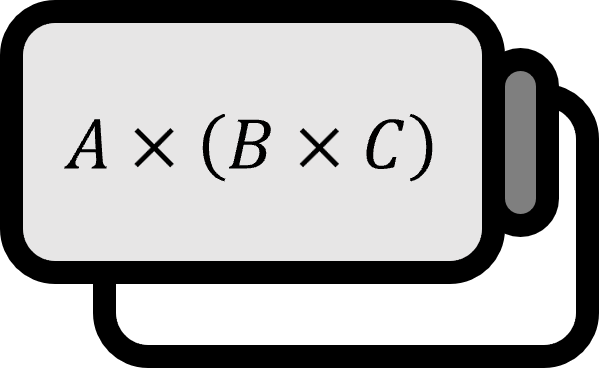Solution of the Laplace Equation Independent of Azimuthal Angle in Spherical Coordinates using the Method of Separation of Variables
Theorem
The general solution of the Laplace’s equation with azimuthal symmetry in spherical coordinates is as follows:
$$ V(r,\theta) = \sum \limits_{l=0} ^\infty \left( A_{l} r^l + \dfrac{B_{l}}{r^{l+1} } \right) P_{l}(\cos \theta) $$
Proof
Step 0
When finding the potential in cases where the boundary condition is easily expressed in spherical coordinates, one must solve the Laplace’s equation for spherical coordinates. The Laplace’s equation in spherical coordinates is as follows. (ref, ref)
$$ \nabla ^2 V = \dfrac{1}{r} \dfrac{\partial}{\partial r} \left( r^2 \dfrac{\partial V}{\partial r} \right) +\dfrac{ 1}{r^2 \sin \theta } \dfrac{ \partial}{\partial \theta} \left( \sin \theta \dfrac{ \partial V}{\partial \theta }\right) + \dfrac{1}{r^2 \sin ^2 \theta} \dfrac{ \partial ^2 V}{\partial \phi^2 }=0 $$
Let’s assume the potential $V$ is a function independent of $\phi$. In other words, when other values remain the same and only $\phi$ changes, the value of $V$ does not change. Then, the change of $V$ with respect to $\phi$ is $0$, and this leads to $\dfrac{\partial V}{\partial \phi}=0$, so the third term disappears.
$$ \dfrac{1}{r} \dfrac{\partial}{\partial r} \left( r^2 \dfrac{ \partial V}{\partial r} \right) +\dfrac{ 1}{r^2 \sin \theta } \dfrac{ \partial}{\partial \theta} \left( \sin \theta \dfrac{ \partial V}{\partial \theta }\right)=0 \tag{1} $$
Let’s assume the potential $V(r, \theta)$ is a function that allows separation of variables. That means we assume $V$ is composed of the product of the function of $r$ alone $R(r)$ and the function of $\theta$ alone $\Theta (\theta) $. Substitute $V(r,\theta)=R(r) \Theta (\theta)$ into $(1)$ and divide both sides by $V$ to simplify it as shown below.
$$ \dfrac{1}{R} \dfrac{d}{d r} \left( r^2 \dfrac{d R}{d r} \right) +\dfrac{ 1}{ \Theta \sin \theta } \dfrac{ d}{d \theta} \left( \sin \theta \dfrac{ d \Theta}{d \theta }\right) = 0 $$
Since each term depends only on $r$ and $\theta$, both terms are constants. The value of the second term and the right side does not change even if $r$ changes. Therefore, the value of the first term must always be the same, which means it is a constant term. The second term is also a constant term for the same reason.
$$ \dfrac{1}{R} \dfrac{d}{d r} \left( r^2 \dfrac{d R}{d r} \right) =l(l+1) $$
$$ \dfrac{ 1}{\Theta \sin \theta } \dfrac{d}{d \theta} \left( \sin \theta \dfrac{d \Theta }{d \theta }\right) = -l(l+1) $$
The complex partial differential equation of $(1)$ has been simplified into two ordinary differential equations. Solving each differential equation to find $R(r)$ and $\Theta (\theta)$ and multiplying them yields the desired $V(r,\theta)$.
Step 1
$$ \dfrac{d}{dr} \left( r^2 \dfrac{dR}{dr} \right) = l(l+1) R $$ $$ \implies 2r \dfrac{dR}{dr} +r^2 \dfrac{d^2 R}{dr^2} =l(l+1)R $$
$$\implies r^2 \dfrac{d^2 R}{dr^2} + 2r\dfrac{dR}{dr} - l(l+1)R=0$$
This takes the form of an Euler equation, and although the solution can be found here, this document will solve it in a simpler manner. Use the fact that the solution to the above differential equation comes out in the form of $r^k$ and substitute $R=r^k$ in the first line. Then,
$$ \dfrac{ d}{dr} \left( r^2 \dfrac{ d r^k}{dr} \right) = l(l+1)r^k$$ $$ \implies \dfrac{d}{dr} (k r^{k+1} ) = l(l+1) r^k$$ $$ \implies k(k+1)r^k=l(l+1)r^k $$ $$ \therefore k(k+1)=l(l+1) $$ $$ \implies k^2+ k -l(l+1)=0$$
Using the quadratic formula, the solution is either $k=l$ or $k=-(l+1)$. Therefore, $r^l$ and $\dfrac{1}{r^{l+1} }$ are solutions to the differential equation. The general solution is a linear combination of the two solutions, so $R(r)=Ar^l + \dfrac{B}{r^{l+1} }$, $A,B$ are constants
Step 2
$$ \dfrac{d}{d\theta} \left( \sin \theta \dfrac{d \Theta }{d \theta} \right) =-l(l+1)\sin \theta \Theta $$
The solution to the differential equation for $\theta$ is complex, so only the result is introduced here. For a detailed solution, refer here. The solution to the above differential equation is the Legendre polynomial for $\cos \theta $.
$$ \Theta (\theta) = P_{l}( \cos \theta) $$
At this time, $P_{l}(x)$ is as follows.
Rodrigues’ formula $$ P_{l}(x) := \dfrac{1}{2^l l!} \left( \dfrac{d}{dx} \right) ^l (x^2-1)^l $$
l$은 양의 정수, $P_{0}(x)=1$
위 공식에 따라 계산한 르장드르 다항식은 아래와 같다.
$$P_{0}(x) =1$$ $$P_{1}(x)=x$$ $$P_2(x) = \dfrac{3x^2-1}{2}$$ $$P_{3}(x) = \dfrac{5x^3 -3x}{2}$$ $$\vdots$$
2계 미분방정식이므로 2개의 해를 구해야하는데 각 $l$ 값에 대해 하나의 해만 있다. 나머지 두번째 해는 $\theta=0$과 $\theta=\pi$에서 발산하기 때문에 물리적인 의미가 있는 해가 아니다. 따라서 드장드르 다항식에 의한 첫번째 해만 고려해주면 된다.
단계 3.
단계 1 과 단계 2 의 결과를 종합하면 전위는
$$ V(r,\theta) =\left( Ar^l ++ \dfrac{B}{r^{l+1}} \right) P_{l}( \cos \theta) $$
이 때 각 $l$ Since there is a solution for each value, the general solution is the sum of all of these.
$$ V(r,\theta) = \sum \limits_{l=0} ^\infty \left( A_{l} r^l + \dfrac{B_{l}}{r^{l+1} } \right) P_{l}(\cos \theta) $$
■
